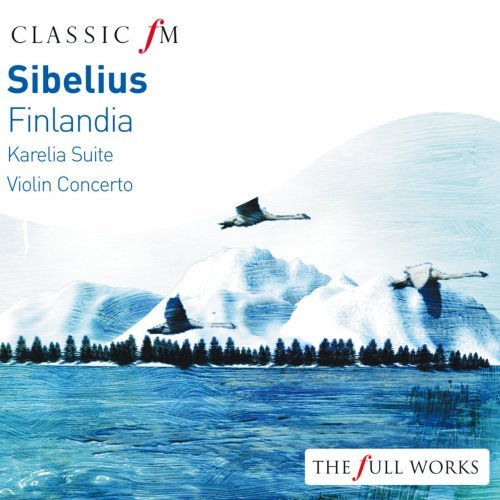
Viktoria Mullova, Seiji Ozawa, Neeme Järvi - Sibelius: Finlandia (2008)
BAND/ARTIST: Viktoria Mullova, Seiji Ozawa, Neeme Järvi
- Title: Sibelius: Finlandia
- Year Of Release: 2008
- Label: Decca
- Genre: Classical
- Quality: FLAC (tracks) / MP3 320 Kbps
- Total Time: 01:14:19
- Total Size: 344 / 190 Mb
- WebSite: Album Preview
Tracklist:
01. Sibelius: Finlandia, Op.26, No.7 - Andante sostenuto - Allegro moderato - Allegro
by Gothenburg Symphony Orchestra and Neeme Järvi
02. Sibelius: Karelia Suite, Op.11 - 1. Intermezzo (Moderato)
by Gothenburg Symphony Orchestra and Neeme Järvi
03. Sibelius: Karelia Suite, Op.11 - 2. Ballade (Tempo di menuetto)
by Gothenburg Symphony Orchestra and Neeme Järvi
04. Sibelius: Karelia Suite, Op.11 - 3. Alla marcia (Moderato)
by Gothenburg Symphony Orchestra and Neeme Järvi
05. Sibelius: Lemminkäinen Suite Op.22 - The Swan Of Tuonela
by Bjoern Bohlin and Gothenburg Symphony Orchestra and Neeme Järvi
06. Sibelius: Valse triste, Op. 44
by Gothenburg Symphony Orchestra and Neeme Järvi
07. Sibelius: Andante Festivo
by Gothenburg Symphony Orchestra and Neeme Järvi
08. Sibelius: Violin Concerto in D minor, Op.47 - 1. Allegro moderato
by Viktoria Mullova & Boston Symphony Orchestra & Seiji Ozawa
09. Sibelius: Violin Concerto in D minor, Op.47 - 2. Adagio di molto
by Viktoria Mullova & Boston Symphony Orchestra & Seiji Ozawa
10. Sibelius: Violin Concerto in D minor, Op.47 - 3. Allegro, ma non tanto
by Viktoria Mullova & Boston Symphony Orchestra & Seiji Ozawa
01. Sibelius: Finlandia, Op.26, No.7 - Andante sostenuto - Allegro moderato - Allegro
by Gothenburg Symphony Orchestra and Neeme Järvi
02. Sibelius: Karelia Suite, Op.11 - 1. Intermezzo (Moderato)
by Gothenburg Symphony Orchestra and Neeme Järvi
03. Sibelius: Karelia Suite, Op.11 - 2. Ballade (Tempo di menuetto)
by Gothenburg Symphony Orchestra and Neeme Järvi
04. Sibelius: Karelia Suite, Op.11 - 3. Alla marcia (Moderato)
by Gothenburg Symphony Orchestra and Neeme Järvi
05. Sibelius: Lemminkäinen Suite Op.22 - The Swan Of Tuonela
by Bjoern Bohlin and Gothenburg Symphony Orchestra and Neeme Järvi
06. Sibelius: Valse triste, Op. 44
by Gothenburg Symphony Orchestra and Neeme Järvi
07. Sibelius: Andante Festivo
by Gothenburg Symphony Orchestra and Neeme Järvi
08. Sibelius: Violin Concerto in D minor, Op.47 - 1. Allegro moderato
by Viktoria Mullova & Boston Symphony Orchestra & Seiji Ozawa
09. Sibelius: Violin Concerto in D minor, Op.47 - 2. Adagio di molto
by Viktoria Mullova & Boston Symphony Orchestra & Seiji Ozawa
10. Sibelius: Violin Concerto in D minor, Op.47 - 3. Allegro, ma non tanto
by Viktoria Mullova & Boston Symphony Orchestra & Seiji Ozawa
The output of the Finnish national composer Jean Sibelius (1865-1957) comprises one of the most fascinating treasure houses of classical music. It includes world favourites such as Valse triste and Finlandia, as well as the most recorded violin concerto of the 20th century. It includes a symphonic cycle that has become one of the most esteemed and popular cycles since Beethoven. It includes small and easily accessible pieces – but also unique masterpieces of great depth, such as Luonnotar and Tapiola.
Sibelius wrote most of his works during the five decades from the beginning of the 1880s to the end of the 1920s. His stylistic development proceeds from his first exercises in the style of the Viennese classical school and early romanticism. It moves via national romanticism to a sort of neoclassicism and to an expressionist-impressionist intermediate stage. Finally it arrives at a renewal and crystallisation of symphonic thought, operating in ways whose significance is only now beginning to be understood in the light of contemporary scholarship.
Sibelius wrote most of his works during the five decades from the beginning of the 1880s to the end of the 1920s. His stylistic development proceeds from his first exercises in the style of the Viennese classical school and early romanticism. It moves via national romanticism to a sort of neoclassicism and to an expressionist-impressionist intermediate stage. Finally it arrives at a renewal and crystallisation of symphonic thought, operating in ways whose significance is only now beginning to be understood in the light of contemporary scholarship.
Classical | FLAC / APE | Mp3
As a ISRA.CLOUD's PREMIUM member you will have the following benefits:
- Unlimited high speed downloads
- Download directly without waiting time
- Unlimited parallel downloads
- Support for download accelerators
- No advertising
- Resume broken downloads


